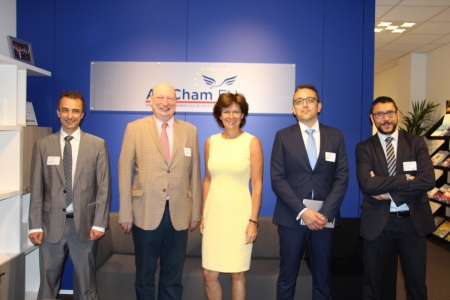You are here
Europe in the driving seat: developing the mobility system of the future
Some 100 years after the Ford Model T took to the road as the first mass-produced car, we are well on the way to the next big innovation in transport: from a mobility system dominated by human-operated motor vehicles to one which places connected and automated vehicles and infrastructure at its centre.

This is a hugely exciting opportunity, but managing this change will be just as complex as the introduction of motorised vehicles.
We recently organised a breakfast event on this topic at AmCham EU and these are some of my takeaways from an exciting discussion, featuring Henrik Hololei, Director General at DG MOVE and business representatives of our member companies.
What was clearest and most exciting to me as a driver was the potential of connected and automated vehicles to revolutionise the way we travel. We can already begin to envisage motorways with no traffic jams, as vehicles calculate the optimal distance between each other to avoid stopping. With intelligent sensors and communication, we could also see road deaths and injuries fall significantly, as vehicles communicate with one another and with road infrastructure to avoid crashes. Those companies involved in this ecosystem, such as 3M, aim for a future with zero road deaths. I am hopeful we are not far away from that. Crucially, automated vehicles could also help drastically reduce CO2 emissions, by improving driving efficiency and fostering vehicle-sharing. Predictive maintenance of components – like tyres – will reduce breakdowns, and allow road users to anticipate when they should be repaired.
But as with any major breakthrough in technology, this change must be managed efficiently, otherwise we are back to the drawing board. From privacy and security to competitiveness, trust and liability, regulators have a gargantuan task ahead of them. They need to put together the pieces of a very intricate puzzle.
With the resources and skills at its disposal, Europe must be at the forefront of this change. The European Commission’s Strategy on the future of mobility can steer the future of connected mobility in the right direction. However, for that to happen, regulators need to be in constant contact with business, to understand both the needs and the trends in innovation.
This will be coupled with the challenge of public opinion and societal acceptance of these new technologies. The public’s reaction to recent incidents involving autonomous cars has been loud and clear: these new technologies must pass the trust test. Societal acceptance will come when we understand both the convenience and security of connected and automated driving, as well as the risks associated with these developments. Regulators and businesses need to work together to allow data to travel within and between these vehicles without posing safety or privacy issues to users. I am convinced that the only way we can achieve this is through spirited cooperation between regulators and all sectors of industry.
Motor vehicles solved the issues of horse-drawn carriages polluting cities with manure and clogging the streets. In its place, they presented myriad new challenges that companies active on connected and automated mobility are now trying to solve. As long as we have learned the lessons from that transition, I am confident that in the next few decades, our transport system can offer countless new opportunities for all road users – whatever their means of travel.
By Susan Danger, CEO, AmCham EU
Read our principles of connected and automated mobility in Europe
